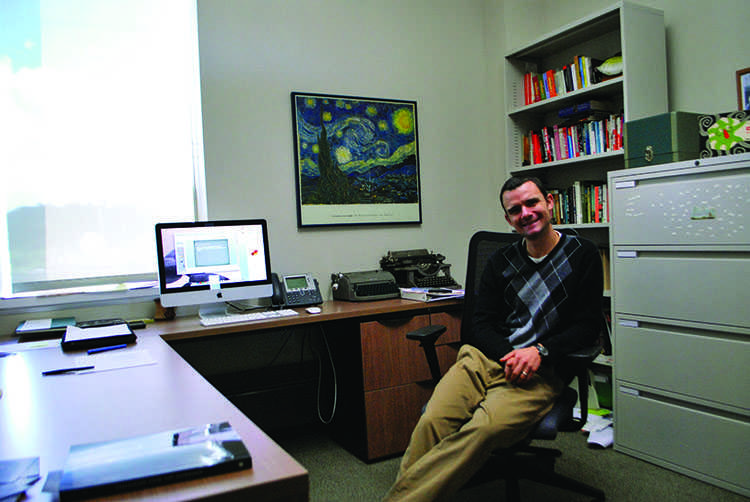Fact or fiction: you decide
Hollars reading allows audience participation
Photo by Anna Mateffy
UW-Eau Claire professor BJ Hollars released his latest book earlier this month.
For most book readings at McIntyre Library, Outreach Coordinator and Instruction Librarian Eric Jennings said he is happy with a turnout of 10 to 15 people. But for assistant professor of English B.J. Hollars’s readings, he expects to easily double that.
Wednesday night, 39 people came to McIntyre Library’s second floor to listen to Hollars read from his new book, “Dispatches from the Drownings: Reporting the Fiction of Nonfiction.” Though the weather outside was gloomy, the room buzzed with the excitement of Hollars’s friends and fans anticipating his arrival.
“I was thrilled with the turnout,” Hollars said. “There’s nothing better than the chance to share work with old friends while making new friends, too.”
This reading, however, was not like most readings. Hollars’s book features 75 factual accounts of drowning alongside 25 fictional accounts, never identifying in the text which are true or made up.
Jennings said Greg Kocken, head of special collections, university archives and records management, pitched an idea to allow the attendees to vote on whether they think the story is true or false by holding up paddles.
“I think the interactivity is going to be the coolest part about this event,” Jennings said. “I think for an author to get a really good reaction from a crowd is going to be really special for him, too.”
Hollars recounted the selection of dispatches one by one, paired with photographs by Charles Van Schaick. The accounts included a variety of characters – or real people – from disgruntled spouses to children at play. Hollars didn’t reveal if the reading was true or not. After each, the audience raised their paddles, casting their vote either way.
Hollars said he was excited about how the paddles connected the audience to the reading.
“I think the paddles were a hit,” he said. “The audience was quite diligent about their choices, and it helped reaffirm one of the book’s major points: that we always need to question the truth.”
Rob Reid, senior education studies lecturer, said he was intrigued at the concept of voting fact or fiction in front of the author himself.
“I’m into audience participation,” Reid said. “But I’d be here even if he droned on for two hours. I just think we’re lucky to have an author of his caliber associated with our campus.”
Several of Hollars’s students showed up to support their professor. Michael Vaughan, a student in one of Hollars’s writing workshops, said he also thinks Hollars is an asset to campus.
“He’s a great, great creative writing professor. He’s really good at getting everyone involved,” Vaughan said. “He’s the perfect workshop professor, I’d say.”
To open the reading, Hollars told the audience about a time he contributed to the falsification of a drowning.
In April 2013, a kayaker reported to the police that two canoeists were missing on the Chippewa River, according to WSAU.
Hollars, who was researching this book at the time, thought he recalled seeing an empty red canoe on the Chippewa River around the time of the disappearance. He reported it to the police.
Days later, it came out that the disappearance of the canoeists was a hoax, and that the kayaker had made the situation up. Hollars cited this as a perfect example of how sometimes hearing a story can make a person fabricate facts to go along with it, just as he did with the fabricated dispatches in his book.
Jennings said he believes this event was beneficial for the audience not only for the opportunity to enjoy the arts, but to learn from Hollars about how to make public speaking fun.
“If anyone wants to get a better understanding of public speaking, B.J. – having been to a couple of his events already – he’s great,” Jennings said. “It would give you an appreciation of what you can do. It doesn’t have to be a dry lecture. You can do things that make it interactive, make it interesting, make it fun for the audience.”






